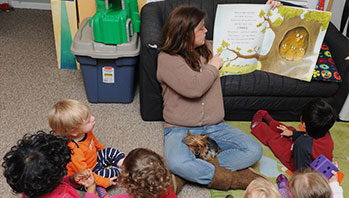- flower
- surprise
- window box
MA Standards:
English Language Arts/Literature/RL.PK.MA.1: With prompting and support, ask and answer questions about a story or a poem read aloud.
English Language Arts/Literature/RL.PK.MA.4: With prompting and support, ask and answer questions about unfamiliar words in a story or poem read aloud.
English Language Arts/Literature/RL.PK.MA.10:Listen actively as an individual and as a member of a group to a variety of age-appropriate literature read aloud.
Head Start Outcomes:
Literacy Knowledge/Book Appreciation and Knowledge: Asks and answers questions and makes comments about print materials.
PreK Learning Guidelines:
English Language Arts/Reading and Literature 6: Listen to a wide variety of age appropriate literature read aloud.
English Language Arts/Reading and Literature 10: Engage actively in read-aloud activities by asking questions, offering ideas, predicting or retelling important parts of a story or informational book.
Read Together: Flower Garden #1

© Commonwealth of Massachusetts, Department of Early Education and Care (Jennifer Waddell photographer). All rights reserved.
STEM Key Concepts: Plants start in different ways; Some plants start from seeds; Some plants start from bulbs; Plants need water and sunlight to grow; Plants grow in places where they get their needs met; Plants often grow in some type of dirt
ELA Focus Skills: Active Listening, Concepts of Print, Listening and Speaking, Story Comprehension, Vocabulary
Before You Read
Show children the cover of the book. Ask if they can find the title. Point to the words and read aloud the title. Ask children to describe what they see on the cover.
Tell children that in the book, the girl and her father gather everything they need to plant a garden. Set a reading focus for children by telling them that you want them to think about two things as they listen: first, what kind of garden do they think the girl and her father might be building; and, second, who do they think the garden might be for?
As You Read
Read slowly and with expression, emphasizing the joyful rhythm and rhyme of the words.
- Use the illustrations to explain the meaning of unfamiliar words and phrases such as checkout stand, trowel, and potting soil.
- Pause on the page where the little girl and her father are on the bus and ask, Why do you think the people on the bus are smiling at the little girl and her father?
- On the page where the dad and the little girl are planting the flowers, say, I noticed that the dad and the little girl need to “hurry, hurry.” I wonder why they have to plant the flowers so fast. Does anyone have any ideas?
- When the father lights the candles on the birthday cake, say, Oh, here’s a clue about why they might be hurrying. They are lighting candles on a birthday cake. I wonder whose birthday it is. Does anyone have a guess? What makes you think so? Let’s read the next page and see.
After You Read
Talk about the story with children.
- Show the page where the girl and her father are planting the flowers. Point to the trowel and say, This is called a trowel. It’s shaped like a spoon and is good for digging. Explain that people have to dig out big rocks and things when they plant seeds so the roots will be able to grow.
- Show the page with the large illustration of the flowers in the window box. As you point to and name each flower, say, What is different about the shapes of the tulip flower and the daisy flower? What is different about the shapes of their leaves?
- What is similar about all of the plants? (green leaves, flowers, roots, leaves) What is different? (shape, size, color) Talk about how the plants are similar and different.
- What was your favorite part of the story? Why did you like that best?
Social Emotional Tip: Offer many opportunities for children to pick a favorite because it helps them acknowledge the importance of their personal likes and dislikes.
English Language Learners: Point to the picture of the window box at the top of the apartment building and reinforce the phrase window box for children. Explain as you trace around the box that the flower garden is in a box and trace around the window as you explain that the box is placed in front of the window.
